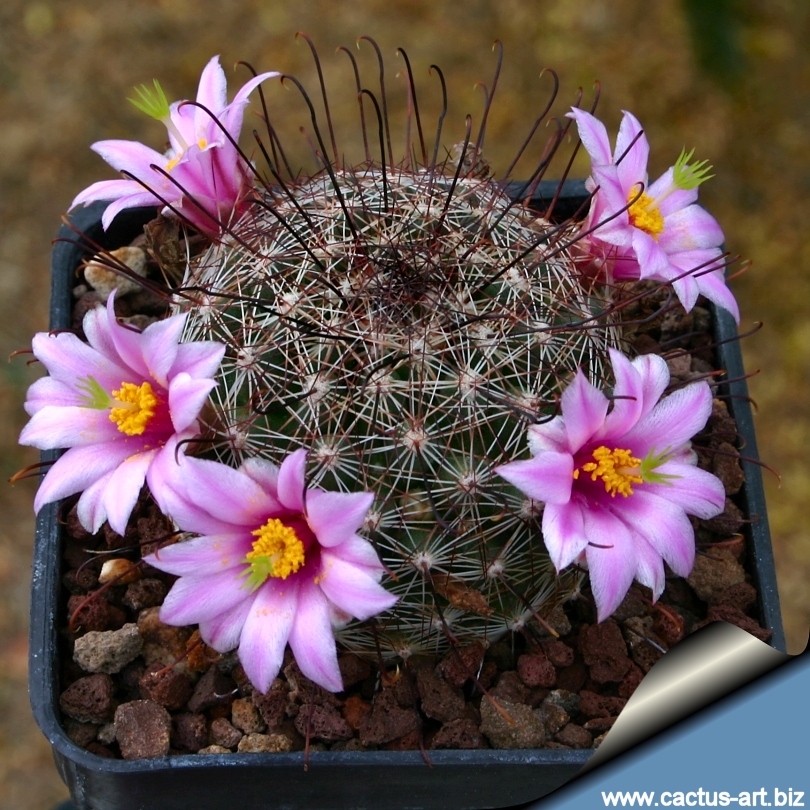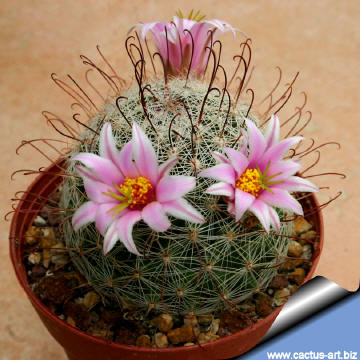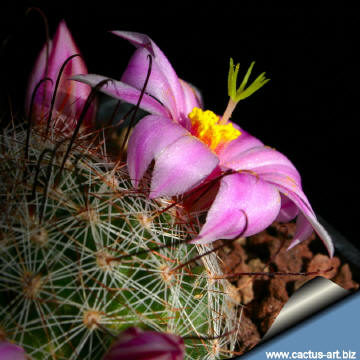|
|
|

Mammillaria grahamii ( SB 218 Samalayuca, Chihuahua, USA
)
A reliable bloomer, it has an attractive form even when not
blooming.
|
|
Description: Plants
are solitary or budding either basally or near
the middle, often
cespitose, but in small clusters (but sometime they can form clusters
of many individuals). This species is quite common in habitat, but
variable throughout the region.
Stems: Globose to short
cylindrical, light green, 7 - 15 cm or more in height, 7.5 - 11 cm in
diameter.
Roots: Thickened.
Sap: Without latex.
Tubercle: Ovoid to cylindrical, often four-angled, corky when old
.
Axil: Naked.
Radial spine: 20 - 35, straight, glabrous, needle-like,
interlacing, so
dense that it is difficult to see the stem body underneath,
white to greyish to light brown to reddish, 6 - 12 mm long, lateral ones
longest.
Central spine: 1 - 4, yellowish brown to (often)
dark brown, 12 - 25 mm long, the
longest one usually hooked.
Flower: The flower is large for the genus, broadly funnel-form,
pink to lavender pink to reddish purple, sometimes white with a deeper
central stripe, 20 - 45 mm in diameter. Tepals, obovate, acuminate,
stile longer than stamens, purplish, stigma lobes 7-8, linear, green.
They
grow just below the top of the cactus and sometimes form perfect,
crown-like rings. The number of flowers produced by an individual plant
depends largely on plant volume.
Blooming season (Europe): Flowers
in the early summer and a plant can produce two or three batches of flowers.
Individual flowers normally live one day, but can open a second day when
pollination is inadequate.
Fruit: Clavate, slightly fleshy, bright red, 12 - 25 mm long.
Seed: Black, shining, pitted, globose 0,8-1 mm in diameter.
|
|
 |
 |
|
Advertising
|
|
|
|
|
Family:
Cactaceae (Cactus
Family)
Scientific name: Mammillaria grahamii
Engelmann
In: Proc. Amer. Acad. 3: 262 (1856)
Origin: California, Arizona, New Mexico and Texas, USA; Sonora,
Sinaloa and Chihuahua, Mexico.
Habitat:
These small cacti is found in desert
mountains, sandy or rocky canyons, washes and plains on igneous or
limestone substrate. They grow in sparse woodland, among desert creosote
shrub or in grassland, and it is very easy to overlook them, except when
they are blooming. They bloom about five days after the first summer
rains of the monsoon. This plants uses
nurse plants to protect against frosts, harsh sun, trampling, etc.
so one must look carefully under shrubs and trees to find them. Altitude
200 -1.550 m.
Conservation status: Listed in
CITES appendix 2.
Common Names include: Graham's Nipple Cactus, Pincushion
Cactus, Arizona Fishhook, Pitahayita, Choyita, Black-spined Pincushion,
Cabeza de Viejo, Fishhook Pincushion, Miller's Pincushion, Olive's
Pincushion, Sunset Cactus.
Etymology: Named after Colonel James
Duncan Graham (1799-1851), Topographical engineer, and surveyor with
the eastern portion of the U.S.-Mexican border survey. Mount Graham in
Arizona was named after him.
Synonyms:
- Chilita grahamii (Engelmann)
Orcutt 1926
- Mammillaria microcarpa ssp. grahamii
(Engelmann) Mottram 1991 (Not validly published)
- Mammillaria microcarpa Engelmann
1848 (Not validly published)
- Chilita microcarpa (Engelmann)
Orcutt 1926
- Ebnerella microcarpa (Engelmann)
Buxbaum 1951
- Mammillaria oliviae Orcutt 1903
- Chilita oliviae (Orcutt) Orcutt
1926
- Ebnerella oliviae (Orcutt)
Bauxbaum 1951
- Neomammilaria millerii Britton &
Rose 1923
- Chilita millerii (Britton & Rose)
Orcutt 1926
- Mammillaria millerii (Britton &
Rose) Boedeker 1933
The degree of difference between Mammillaria
grahamii and Mammillaria microcarpa is still a
matter for debate.
|
|
|
|
Cultivation: This plant is not
famous for being easy to cultivate, but in good conditions with
excellent
ventilation,
it grows without difficulty.
It is especially sensitive to over-watering.
So careful watering and an open
mineral
potting soil are a must.
Avoid
the use of
peat or other
humus sources in the
potting mixture.
Don't add
limestone
to the potting
mix, which must be moderately acidic. It can be
sensitive to frost (but some population are resistant to -10° C). It
requires maximum
sun exposure
to reach its full potential,
and to
achieve success in
flowering.
A winter rest that allows the plant to shrivel (perhaps losing up to 25%
of its summer height) will encourage flowering and long time survival.
Be careful to encourage slow growth.
Propagation: Seeds or
offsets.
Traditional uses:
- Apache, Pima, Chiricahua &
Mescaleros: They used the fresh and dried fruit primarily
for
children, as a snack food..
- Pima: They used the boiled
plant placed warm in the ear for earaches and suppurating ears.
- Seri And Pima also used it in special
ceremonies by shamans. Fruits are also said to produce hallucinatory
effects.
|
|

 |
|